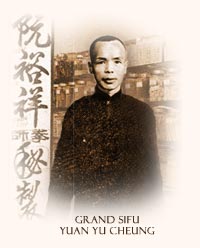Fu Hok Medicine
(Fu Hok Yau Kong Dit Da Ke)

Grandmaster Yuan Yu Cheung practiced Chinese medicine during the day while teaching his disciples the Fu Hok fighting system and medicine in the evenings. In master Kwan Wing Hung’s home there was continually the smell of “jooks” (medicinal soups) cooking while in nearly every corner of his house were large jars of aging medicinal wines or “jows.” When treating injuries, master Kwan’s probing fingers amazingly seemed to be more sensitive and informative than x-rays. In Hong Kong the Fu Hok medical tradition continues to be passed on to this day.
Traditional Chinese Medicine (TCM) is the government sanctioned Confucian style of medicine dominant in mainland China (PRC) today. Buddhist monk medicine or seng yi is different from TCM and serves as the basis of the Fu Hok Dit Da medicine.
 The Fu Hok medicine (FHM) was developed, and refined over generations being traditionally handed down from master to disciple. Fu Hok medicinal skills and herbal formulas are typically “closed door” being kept within the Fu Hok family and away from the public. The Fu Hok medicine (FHM) was developed, and refined over generations being traditionally handed down from master to disciple. Fu Hok medicinal skills and herbal formulas are typically “closed door” being kept within the Fu Hok family and away from the public.
Because martial arts involve both training and application, injuries are inevitable. Dit Da has historically encompassed categories that we know today as sports medicine as well as trauma medicine. It involves both the treatment and prevention of internal as well as external injuries. Dit Da Ke (Cantonese) is commonly translated into English as “fall and strike medicine” or “iron strike medicine.”
Injuries in the martial arts may occur for a variety of reasons including getting hit, falling down, pulling or tearing muscle to name only a few. External injuries include bruises, sprains, strains, cuts, dislocations and fractures. Internal injuries include damage to the bowels (hollow) and viscera (solid) and other deep structures of the head, chest, and abdomen. In martial arts the most common internal injuries are internal bleeding, blood clots, and damage to the internal organs.
Dit Da employs a variety of traditional methods or a combination of methods to treat injuries. These methods may include massage, herbal medicine, chi gung, diet, bone setting, acupuncture, moxibustion, plasters, scraping and cupping. If used and applied judiciously these methods are extremely effective with no negative side effects.
Naturally from a western perspective, traditional Chinese medicine is viewed with skepticism. Certainly both eastern and western medical traditions have had their share of charlatans and snake oil salesmen. What’s important when it comes to treating illnesses and injuries is practicality as well as methods or modalities that have proven themselves to be effective over time.
The prudent course of action for the modern day practitioner of Dit Da is to research and preserve what has proven to be effective in traditional medicine, while continually staying current and up to date on modern advances and innovations. In other words, deepen the root, grow the blossom. Given the magnitude of medical knowledge available today, this is no small task. The ethical practitioner then will practice only within his area of expertise and refer to other specialists when situations require skills and knowledge beyond his scope of practice. He will also practice only within the legal bounds of the law. |